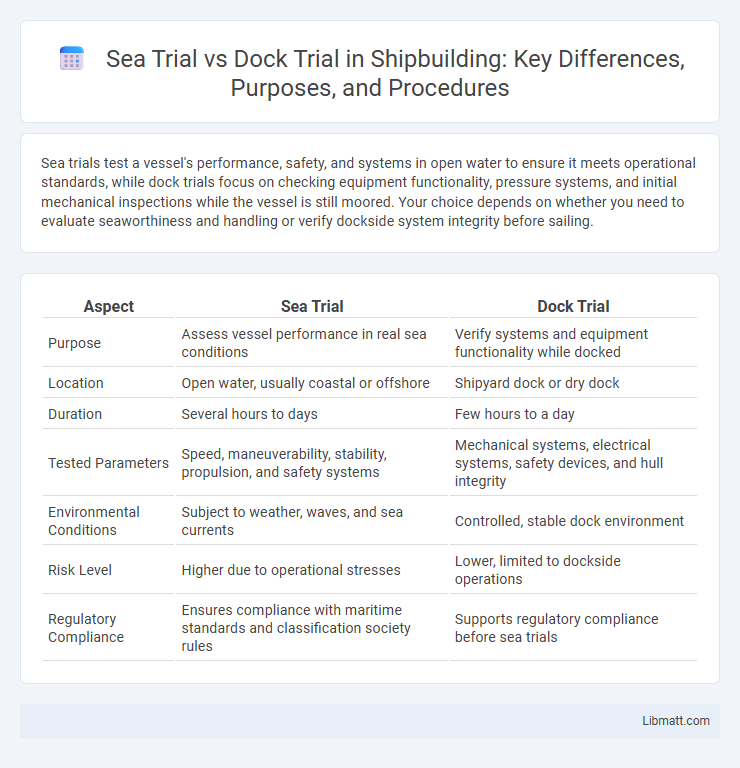Sea trials test a vessel's performance, safety, and systems in open water to ensure it meets operational standards, while dock trials focus on checking equipment functionality, pressure systems, and initial mechanical inspections while the vessel is still moored. Your choice depends on whether you need to evaluate seaworthiness and handling or verify dockside system integrity before sailing.
Table of Comparison
| Aspect | Sea Trial | Dock Trial |
|---|---|---|
| Purpose | Assess vessel performance in real sea conditions | Verify systems and equipment functionality while docked |
| Location | Open water, usually coastal or offshore | Shipyard dock or dry dock |
| Duration | Several hours to days | Few hours to a day |
| Tested Parameters | Speed, maneuverability, stability, propulsion, and safety systems | Mechanical systems, electrical systems, safety devices, and hull integrity |
| Environmental Conditions | Subject to weather, waves, and sea currents | Controlled, stable dock environment |
| Risk Level | Higher due to operational stresses | Lower, limited to dockside operations |
| Regulatory Compliance | Ensures compliance with maritime standards and classification society rules | Supports regulatory compliance before sea trials |
Introduction to Sea Trials and Dock Trials
Sea trials evaluate a vessel's performance, safety, and seaworthiness under real operating conditions, testing engines, navigation systems, and hull integrity on open water. Dock trials occur within a harbor or dock, focusing on machinery function, system checks, and initial operational readiness without exposure to full sea conditions. You rely on both trial types to ensure comprehensive assessment before a ship's official deployment.
Key Differences Between Sea Trials and Dock Trials
Sea trials evaluate a vessel's performance and systems in open water, testing navigation, speed, propulsion, and safety under real operating conditions. Dock trials occur while the ship remains moored, focusing on machinery function, system checks, and equipment operation without leaving the dock. Key differences include the environment of testing, scope of trials, and the real-world operational factors assessed during sea trials compared to the controlled setting of dock trials.
Purpose and Objectives of Sea Trials
Sea trials assess a vessel's performance, safety, and seaworthiness under real operational conditions to verify compliance with design specifications and regulatory standards. The primary objectives include testing propulsion systems, navigation equipment, stability, and maneuverability in open water to ensure reliability before delivery. Dock trials, by contrast, focus on initial mechanical and system checks within the harbor to confirm equipment functionality and readiness for subsequent sea trials.
Purpose and Objectives of Dock Trials
Dock trials primarily aim to verify the functionality and performance of a ship's systems, machinery, and equipment while the vessel remains moored. These tests ensure that engines, navigation systems, safety apparatus, and communication devices operate according to specifications before the ship embarks on sea trials. Successful dock trials confirm operational readiness and identify potential issues early, reducing risks during subsequent open-water testing.
Testing Procedures in Sea Trials
Sea trials involve comprehensive testing procedures that evaluate a vessel's performance, stability, speed, and safety under real maritime conditions. Unlike dock trials that focus on systems and equipment checks while the vessel is stationary, sea trials subject your ship to operational stresses, navigational challenges, and environmental factors to ensure reliability and compliance with regulatory standards. This hands-on testing helps identify potential issues in propulsion, steering, and onboard systems before full deployment.
Testing Procedures in Dock Trials
Dock trials focus on comprehensive equipment and system checks conducted while the vessel is stationary, ensuring all machinery, engines, and safety systems operate correctly before departure. Testing procedures include engine performance assessments, navigation system calibrations, and safety drills verified in a controlled environment. Your vessel's readiness is optimized by addressing any mechanical or operational issues detected during these dockside evaluations.
Equipment and Systems Evaluated
Sea trials primarily evaluate the vessel's performance under real operating conditions, testing navigation systems, propulsion, steering, and safety equipment such as lifeboats and fire suppression systems. Dock trials concentrate on assessing individual machinery and systems while the ship remains moored, including engine functions, electrical systems, and communication equipment checks. Both trials ensure that all equipment and systems meet technical specifications and regulatory standards before final delivery.
Advantages and Limitations of Sea Trials
Sea trials provide critical real-world testing of a vessel's performance, safety, and handling under actual sea conditions, which cannot be replicated during dock trials. They enable the identification of issues related to propulsion, navigation, and structural integrity, ensuring compliance with maritime regulations before commissioning. However, sea trials are costly, weather-dependent, and pose safety risks, limiting their frequency and duration compared to controlled dock trials.
Advantages and Limitations of Dock Trials
Dock trials offer precise control over testing conditions, enabling engineers to evaluate specific systems such as propulsion and steering without the interference of environmental variables. Limited by their static nature, dock trials cannot simulate real sea conditions like wave impacts or vessel maneuverability under dynamic loads, restricting the scope of performance assessment. These trials are advantageous for early detection of mechanical issues and system calibration, but must be complemented by sea trials to ensure comprehensive vessel functionality and safety.
Choosing Between Sea Trial and Dock Trial
Choosing between a sea trial and a dock trial depends on the vessel's specific testing requirements and operational goals. Sea trials evaluate a ship's performance in real maritime conditions, testing speed, maneuverability, and safety systems, while dock trials focus on the functionality of machinery and equipment in a controlled environment. Decision-makers prioritize sea trials for comprehensive operational assessments and dock trials for initial equipment verification and repairs.
Sea trial vs dock trial Infographic

 libmatt.com
libmatt.com